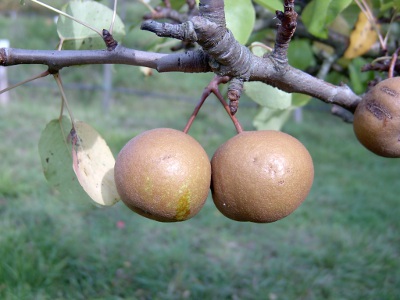︎︎︎ PERA VOLPINA

La pianta madre è stata rinvenuta nel comune di Gualdo Tadino (PG) e in seguito anche in quello di Gubbio (PG). E’ diffusa in tutto l’Appennino Centro settentrionale, non se ne conosce l’origine. Veniva coltivata nelle zone di alta collina di queste zone, in piante singole. La pianta è molto vigorosa, rustica e a portamento espanso. E’ molto produttiva e fiorisce tardivamente. Il frutto è di piccola pezzatura (gr. 80-100), questa pera ha forma rotondeggiante e appiattita, con il peduncolo lungo e ricurvo. La cavità calicina è piccola e poco profonda. La buccia molto spessa è ruvida al tatto, con colore di base verde ma con rugginosità diffusa che copre totalmente il frutto. La polpa è bianca e poco succosa, con media granulosità . Viene raccolta in novembre, dopo le prime brinate, può essere lasciata in fruttaio in mezzo alla paglia per la maturazione, che in realtà consiste nella sovramaturazione o ammezzimento, quando cioè la polpa diventa marrone e morbida.
E’ un frutto molto rustico, per un consumo particolare, soprattutto da cottura e da conserva. Si mangia crudo solo se viene fatto ammezzire come le sorbe. Il gusto di queste pere viene esaltato dalla cottura in un buon vino rosso, intere con la loro buccia, zucchero quanto basta e aromatizzate con cannella e chiodi di garofano. Il nome sembra sia dovuto al fatto che le volpi ne siano molto ghiotte.
The mother plant was recovered in the area of Gualdo Tadino (Perugia) and after that also in the area of Gubbio (Perugia). Its origin is unknown; isolated specimens used to be cultivated in the high hills of these areas. The plant is very vigorous, hardy and with a spreading habit. It is very productive and blooms late. The fruit It is small, roundish and flattened. The stem is long and bent. The calyx is small and not too deep. The skin is very thick and hardy to the touch, with a green background, and a russeting covering the whole fruit. The flesh is white, not too juicy and moderately granular. It is harvested in November, after the first frosts, and can be stored in the fruit-house in the straw. In this is way the fruit turns overripe and soft and its flesh brown and tender. It is a very hardy fruit and suitable for cooking and jamming. It is eaten fresh only if it is left to soften as it is done with sorb apples. The flavor of these pears is enhanced by cooking them with red wine of good quality, left whole and with their skin on, with a little bit of sugar as required, and aromatized with cinnamon and clove. Their name may come from the fact that foxes are greedy for these fruits.